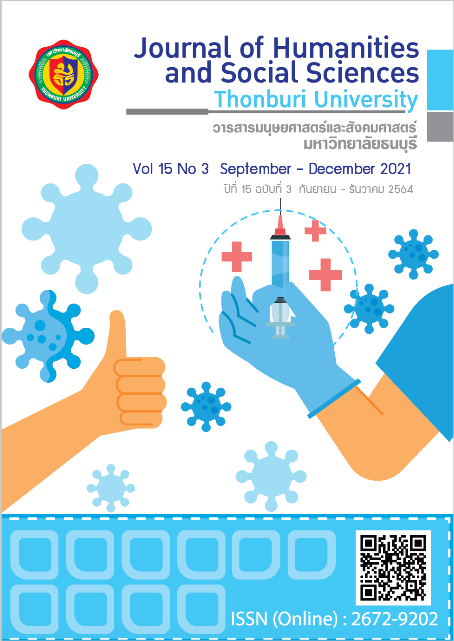การศึกษาเชิงสำรวจของปัจจัยที่มีผลต่อความร่วมมือในห่วงโซ่อุปทานในอุตสาหกรรมโคนมของประเทศไทย
คำสำคัญ:
ความร่วมมือในห่วงโซ่อุปทาน, ปัจจัย, อุตสาหกรรมโคนม, การวิเคราะห์องค์ประกอบเชิงสำรวจบทคัดย่อ
อุตสาหกรรมโคนมของประเทศไทยเป็นแหล่งโปรตีนสำหรับประชาชน อย่างไรก็ตาม 90% ของผู้ผลิตนมเป็นรายย่อย นอกเหนือจากการควบคุมโรคและกฎระเบียบด้านสุขภาพแล้วการสนับสนุนผู้ผลิตนมในการทำงานร่วมกันในห่วงโซ่อุปทานยังมีส่วนสำคัญในการปรับปรุงความสำเร็จของอุตสาหกรรมโคนม การทำความเข้าใจปัจจัยที่มีผลต่อสิ่งนี้จะนำไปสู่ความสำเร็จในการทำงานร่วมกันในห่วงโซ่อุปทาน การศึกษานี้รวบรวมตัวแปร 95 ตัวจากการทบทวนวรรณกรรมจากเอกสารงานวิจัย จากนั้นมีกระบวนการสัมภาษณ์ผู้เชี่ยวชาญเพื่อกลั่นกรองตัวแปรสำคัญจนเหลือจำนวน 49 ตัว นอกจากนี้การศึกษานำร่องนี้มีวัตถุประสงค์เพื่อพัฒนากรอบแนวคิด โดยจากการวิเคราะห์ปัจจัยเชิงสำรวจพบว่ามี 27 ปัจจัยที่มีอิทธิพลต่อกรอบแนวคิด และสามารถพัฒนากรอบแนวคิดทั้ง 7 ด้านดังนี้ ธุรกิจระยะยาว การวัดและประเมินผล การสื่อสารภายในและภายนอก ปฏิบัติการร่วม ปฏิสัมพันธ์ การแบ่งปัน อุปสงค์และอุปทานซึ่งจากการศึกษาครั้งนี้ได้สร้างแบบจำลองที่สามารถให้ความเข้าใจที่ชัดเจนยิ่งขึ้นเกี่ยวกับปัจจัยที่มีผลต่อความร่วมมือในห่วงโซ่อุปทานที่ส่งผลกระทบต่ออุตสาหกรรมนมของประเทศไทย โดยสามารถให้การสนับสนุนปัจจัยหลักที่สำคัญเพื่อการพัฒนาของอุตสาหกรรมต่อไป
References
Akintoye, A., McIntosh, G., & Fitzgerald, E. (2000). A survey of supply chain collaboration and management in the UK construction industry. European Journal of Purchasing & Supply Management, 6, 159-168.
Aschemann-Witzel, J., de Hooge, I. E., Rohm, H., Normann, A., Bossle, M. B., Grønhøj, A., & Oostindjer, M. (2017). Key characteristics and success factors of supply chain initiatives tackling consumer-related food waste e A multiple case study. Journal of Cleaner Production, 155, 33-45.
Banchuen, P., Sadler, I., & Shee, H. (2017). Supply chain collaboration aligns order-winning strategy with business outcomes. IIMB Management Review 29, 109-121.
Banomyong, R. (2018). Collaboration in Supply Chain Management: A Resilience Perspective. Discussion Paper. The International Transport Forum, ITF ROUNDTABLE, 171.
Barratt, M. A. (2004). Understanding the meaning of collaboration in the supply chain. Supply Chain Management: An International Journal, 9(1), 30-42.
Cao, M., & Zhang, Q. (2011). Supply chain collaboration: Impact on collaborative advantage and firm performance. Journal of Operations Management, 29, 163–180.
_______. (2010). Supply chain collaborative advantage: A firm’s perspective. Int. J. Production Economics, 128, 358-367.
Chen, L., Zhaoa, X., Tang, O., Price, L., Zhang, S., & Zhu, W. (2017). Supply chain collaboration for sustainability: A literature review and future research agenda. International Journal of Production Economics, 194, 73–87.
Cohen, S., & Roussel, J. (2005). Strategic Supply Chain Management. Chapter 4 Core Discipline 4: Build the Right Collaborative Model, 139-140.
Dania, W. A. P., Xing, K., & Amer, Y. (2018). Collaboration behavioural factors for sustainable agri-food supply chains: A systematic review. Journal of Cleaner Production, 186, 851-864.
Fabrigar, L. R., & Wegener, D. T. (2012). Understanding Statistics: Exploratory factor analysis. Oxford University Press, 159.
Herczeg, G., Akkerman, R., & Hauschild, M.Z. (2017). Supply chain collaboration in industrial symbiosis networks. Journal of Cleaner Production, 171, 1058-1067.
Horvath, L. (2001). Collaboration: the key to value creation in supply chain management, Supply Chain Management: An International Journal, 6(5)5, 205-207.
Huang, L., Lin, Y., Ieromonachou, P., Zhou, L., & Luo. J. (2015). Drivers and Patterns of Supply Chain Collaboration in the Pharmaceutical Industry: A Case Study on SMEs in China. Open Journal of Social Sciences, 3, 23-29.
Kumar, G., & Banerjee, R. N. (2012). Collaboration in supply chain: An assessment of hierarchical model using partial least squares (PLS), International Journal of Productivity and Performance Management, 61(8), 897-918.
Lemma, H. (2015). Measuring Supply Chain Coordination in Milk and Dairy Industries: A Confirmatory Factor Model. International Journal of Economics & Management Sciences, 4(4), 244.
Matopoulos, A., Vlachopoulou, M., Manthou, V., & Manos, B. (2007). A conceptual framework for supply chain collaboration: empirical evidence from the agri-food industry, Supply Chain Management: An International Journal, 12(3), 177-186.
Min, S., Roath, A. S., Daugherty, P. J., Genchev, S. E., Chen, H., Arndt, A. D., & Richey, R. G. (2005). Supply chain collaboration: what’s happening? The International Journal of Logistics Management, 16(2), 237-256.
Nagashima, M., Wehrle, F.T., Kerbache, L., & Lassagne, M. (2015). Impacts of adaptive collaboration on demand forecasting accuracy of different product categories throughout the product life cycle, Supply Chain Management: An International Journal, 20(4), 415-433.
Nakano, M. (2009). Collaborative forecasting and planning in supply chains: The impact on performance in Japanese manufacturers, International Journal of Physical Distribution & Logistics Management, 39(2), 84-105.
Prajogo, D., & Olhager, J. (2012). Int.J.Production Economics, 135, 514-522.
Ramanathan, U. (2014). Performance of supply chain collaboration – A simulation study. Omega –Expert Systems with Applications, 41, 210220.
Ramanathan, U., & Gunasekaran, A. (2014). Supply chain collaboration: Impact of success in long-term partnerships. International Journal of Production Economics, 47, 252–259.
Ramanathan, U. (2013). Aligning supply chain collaboration using Analytic Hierarchy Process. Omega-The International Journal of Management Science, 41(2), 431–440.
Ramanathan, U., Gunasekaran, A., & Subramanian, N. (2011). Performance metrics for collaborative supply chain: A conceptual framework from case studies. Benchmarking: An International Journal, 18(6), 856–872.
Raweewan, M., & Ferrell Jr., W. G. (2018). Information sharing in supply chain collaboration. Computers & Industrial Engineering, 126, 269–281.
Rovinelli, R. J., & Hambleton, R. K. (1977). On the use of content specialists in the assessment of criterion-referenced test item validity. Dutch Journal of Educational Research, 2, 49–60.
Salam, M. A. (2017). The mediating role of supply chain collaboration on the relationship between technology, trust and operational performance: An empirical investigation, Benchmarking: An International Journal, 24(2), 298-317.
Simatupang, T.M., & Sridharan, R. (2004). Benchmarking supply chain collaboration: An empirical study, Benchmarking. An International Journal, 11(5), 484-503.
_______. (2007). The architecture of supply chain collaboration, Int. J. Value Chain Management, 1(3), 304–323.
_______. (2008). Design for supply chain collaboration. Business Process Management Journal, 14 (3), 401-418.
Soosay, C.A., Hyland, P. W., & Ferrer, M. (2008). Supply chain collaboration: capabilities for continuous innovation. Supply Chain Management: An International Journal, 13/2, 160–169.
Stank, T.P., Keller, S. B., & Daugherty, P. J. (2001). Supply Chain Collaboration and Logistical Service Performance. Journal of Business Logistics, 22(1), 29-48.
Van der Heijden, A., & Cramer, J. (2017). Change agents and sustainable supply chain collaboration: A longitudinal study in the Dutch pig farming sector from a sensemaking perspective. Journal of Cleaner Production, 166, 967-987.
Vereecke, A., & Muylle, S. (2005). Performance Improvement Through Supply Chain Collaboration: Conventional Wisdom Versus Empirical Findings. Working Paper, Faculty of Economics, Ghent University and Vlerick Leuven Gent Management School, 291.
_______. (2006). Performance improvement through supply chain collaboration in Europe, International Journal of Operations & Production Management, 26(11), 1176-1198.
Zhang, Q., & Cao, M. (2018). Exploring antecedents of supply chain collaboration: Effects of culture and interorganizational system appropriation. International Journal of Production Economics, 195, 146-157.






